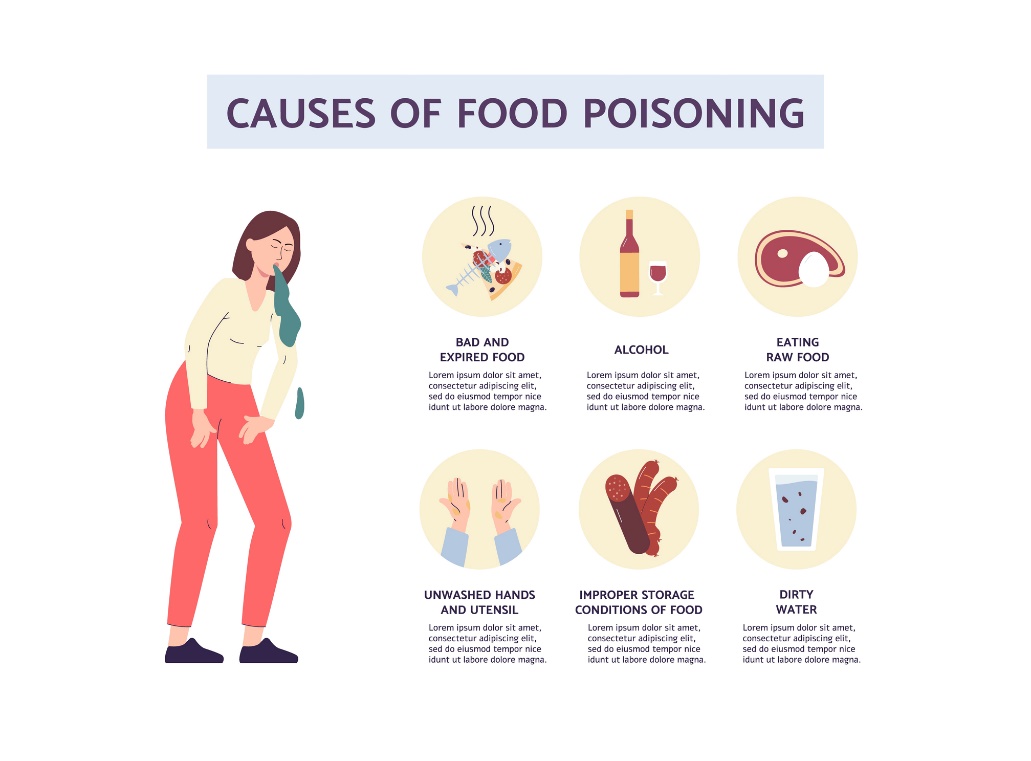- solen.cz - Unusual cause of chronic vomiting. Solen. MUDr. Patrik Konopásek, MUDr. Lucie Holubová, doc. MUDr. Jakub Zieg, Ph.D.
- solen.cz - Vomiting child. Solen. MUDr. Katarína Mitrová, PhD.
- healthline.com - Causes of Vomiting and How to Treat in Adults, Babies, and When Pregnant. Healthline. Jacquelyn Cafasso
- medicalnewstoday.com - Causes and treatment of nausea and vomiting. Medical News Today. Yvette Brazier
Vomiting and nausea after eating: possible causes and treatment

Vomiting is a defensive reflex of the body to get rid of the contents of the digestive tract. The cause may be a dietary error, a psychological factor or a clinical symptom of a particular disease. What are all the possible causes of nausea and vomiting after eating?
What are the most common causes of vomiting after eating? What other health problems can accompany it? What about diagnosis or treatment?
Vomiting is an unwanted phenomenon in which food is regurgitated from the stomach outwards through the oral cavity. It is accompanied by discomfort, abdominal cramps and nausea.
There are several reasons why the human body reacts by vomiting. The mechanism of vomiting, the causes, the accompanying symptoms, treatment options and many other interesting information can be found in this article.
How and why does vomiting occur?
Vomiting (professionally called vomitus) is a defensive reflex of the digestive system by which the body gets rid of unsuitable stomach contents. Unsuitable can be excessive amounts of food, chemically and microbiologically damaging/irritating food.
Vomiting is possible due to the upward reverse peristalsis of the digestive tube. At the same time, it is an acute and violent contraction of the abdominal musculature. The contraction of the musculature brings with it unpleasant or painful cramps in the abdominal region.
The instruction to vomit occurs after irritation of the vomiting centre, which is located in the medulla oblongata of the nervous system. The centre controls the contraction of the diaphragm, the abdominal muscles, the reverse peristalsis of the alimentary canal and the relaxation of the muscular sphincter of the oesophagus.
When vomiting occurs, the vocal cords close. This prevents the body from allowing vomit to enter the airways.
Vomiting is usually preceded by an unpleasant feeling of nausea (professionally called nausea).
There are 4 main mechanisms that stimulate the vomiting process:
- Irritation of mechanical/chemical receptors in the tract
- The action of toxins in the bloodstream
- Emotional reactions
- Irritation of the vestibular apparatus
10x etiology and possible causes of vomiting
The etiology of vomiting after eating is multifactorial. It may be due to central or peripheral nervous causes, poisoning, intoxication, trauma, acute and chronic diseases of the digestive system, hormonal imbalance, psychogenic factor or local gastric irritation.
Prolonged recurrent vomiting or acute non-specific vomiting should be immediately consulted with a physician.
The following are examples of possible causes of vomiting and nausea after eating:
1. Dietary error and inappropriate diet
Excessive distension of the digestive tract can irritate mechanical receptors. Rapid eating (gobbling), overeating and simultaneous obstruction of the tract will cause distension of the stomach and subsequent nerve impulses to the vomiting mechanism.
Dietary error is also the consumption of inappropriate food, e.g., past the expiration date or contaminated food that contains certain pathogens that irritate the chemoreceptors of the gastrointestinal tract.
The most common defects include undercooked food and inadequately washed contaminated food.
Accompanying dietary defects are abdominal pain, cramps and a feeling of nausea.
2. Food intolerance and allergy
If you suffer from a food intolerance (lactose, milk protein, gluten...) or food allergy (gluten, type of nuts/fruit...), vomiting is a possible symptom relatively soon after consuming the inappropriate food or dietary component.
Accompanying food intolerances are abdominal pain, cramps, problems with defecation, nausea and vomiting. In allergies, an immune allergic reaction such as itching, swelling of the sinuses or skin rash and eczema can also be observed.
3. Psychogenic factor
One of the basic triggering mechanisms of vomiting is the emotional factor. Excessive stress, acute stress, anxiety/depression, severe emotional tension, traveling, etc.
Eating disorders such as bulimia are also partly included. In bulimia, the individual induces vomiting after eating deliberately to empty the stomach contents.
4. Infectious and acute diseases of the digestive system
Bacterial or viral infections affecting the digestive system cause vomiting, abdominal pain, nausea, general weakness, headache, problems with defecation and, in most cases, an increase in body temperature (fever).
Acute inflammation caused by a pathogen in some part of the digestive tract(acute gastritis, intestinal flu...) usually persists only for a short time - on average 3 to 5 days.
The risk is excessive fluid loss and dehydration of the organism.
Beware of severe sudden pain, vomiting without a clear cause or other non-specific clinical signs. It may be appendicitis and other acute illnesses leading to the need for sudden specialist treatment.
Diagnosis of the exact pathogen in the organism and establishment of expert treatment with antibiotics or other supportive pharmacotherapy is necessary.
5. Chronic diseases of the digestive system
Even long-term chronic digestive diseases can cause nausea or vomiting. This condition often comes with other clinical symptoms such as stomach pain, diarrhoea/constipation or cramps.
Chronic inflammatory bowel diseases, such as ulcerative colitis and Crohn's disease, can also cause digestive discomfort in the form of nausea and vomiting if the course of the disease worsens or irritates the bowel.
Examples include irritable bowel syndrome and irritable stomach syndrome, where overactivity and nervous sensitivity of the digestive tract causes bloating, abdominal cramps, nausea, vomiting or heartburn after eating.
6. Irritation by a chemical substance (alcohol, drug...)
Consumption of excessive amounts of alcohol can cause damage and irritation to the chemical receptors of the digestive system. Alcohol directly affects the vomiting nerve centre. Alcohol can also react inappropriately with stomach acid.
Either by consumption or by irritation of the olfactory center by chemicals (application of a dangerous substance such as a toxin, drug, and certain drug therapy), the mechanism of vomiting can occur.
7. Irritation of the balance system
The vestibular apparatus is the sensory organ for balancing the head and body in space. Irritation and stimulation of the balance apparatus in the inner ear can induce a mechanism of vomiting.
Unpredictable movements, heights, specific unusual activities, travelling in a vehicle or illness of the balance system can lead to nausea, kinetosis and vomiting.
8. Neurological disease
Some diseases of the nervous system can directly irritate the vomiting centres. These include meningitis, encephalitis, brain swelling, migraine, concussion, brain haemorrhage, brain tumours or intracranial hypertension (increased pressure and tension).
However, these are diseases and medical conditions that require specialist diagnosis and treatment by a doctor.
9. Accompanying symptom of another disease
As vomiting is a fairly widespread clinical symptom, it can also relate to diseases outside the nervous and digestive systems.
Examples include inflammation and disease of the kidneys, cholecystitis, cancer, and the result of certain drug therapy, chemotherapy or radiotherapy.
10. Pregnancy (gestation)
A characteristic health problem in pregnancy is the so-called morning sickness (however, it may not occur only in the morning), which may cause vomiting. Nausea also occurs after eating food.
This condition is caused by higher levels of the female hormone progesterone, which also reduces the production of gastric juices and the motility (mobility) of the stomach wall.
Pregnancy nausea usually manifests itself mainly in the first trimester of pregnancy, after which it gradually disappears. However, monitoring by a gynaecologist/obstetrician is necessary.
Summary of possible causes of the feeling of nausea and vomiting:
- Consumption of excessive amounts of food
- Consumption of inappropriate contaminated food
- Prolonged inappropriate diet and lifestyle
- Inadequate processing of food in the mouth
- Excessive alcohol consumption
- Poisoning and intoxication by an inappropriate substance
- Food allergy and intolerance
- Eating disorders
- Adverse effect of drug therapy
- Psychological factor (stress, travel, anxiety...)
- Low blood pressure
- Reaction to strong smell
- Acute and chronic diseases of the digestive system
- Inflammatory diseases of the intestinal tract
- Irritable bowel/stomach syndrome
- Migraine and headache
- Balance disorder in the middle ear
- Accompanying symptom of another disease
- Period of a woman's pregnancy
- Hormonal change in the context of PMS

Accompanying symptoms and manifestations of vomiting
Vomiting is an undesirable phenomenon that often brings with it other symptoms and signs. Their presence and combination depends on the etiology and cause of the vomiting. But when should medical help be sought?
Possible accompanying symptoms:
- Abdominal pain
- Abdominal cramps
- Nausea
- Headache and migraine
- Dizziness
- Feeling of dry mouth
- Unpleasant bad breath
- Excessive sweating
- Decreased frequency of defecation
- Increased body temperature
- General weakness and excessive fatigue
- Stress and feeling of anxiety
- Dehydration
When should medical help be sought?
- Sudden acute attacks of vomiting lasting more than 12 hours
- Prolonged vomiting and nausea
- If it is a newborn
- Feeling faint
- Vomit contains blood
- Vomit contains black clots
- If the cause may be medications you should take
- Consumption of poisonous food
- Consuming unprocessed risky food
- Consuming a drug, toxin or excessive amounts of alcohol
- Excessively elevated body temperature (fever)
- Travel history from tropical countries
Vomiting in young children
Children and adults have the same mechanism of vomiting. If the central nervous system receives sensation for irritation of the stomach, expulsion of stomach contents occurs.
However, children vomit slightly more often than adults. This is due to a more sensitive immune system.
Vomiting (belching) after breastfeeding or feeding artificial milk is a common and natural phenomenon that gradually disappears with development.
However, if the child shows frequent vomiting or other signs of illness (colic, diarrhoea, blood and mucus in the stool, increased temperature, etc.), an urgent visit to the doctor is necessary.
Possible reasons why children vomit non-specifically:
- Diseases of the stomach and intestines (gastroenteritis, intestinal flu...)
- Food allergy
- Other infections (meningitis, pneumonia, middle ear infection...)
- Concussion
- Food poisoning
When to see a doctor with my child?
- If it is a newborn
- If vomiting and abdominal pain lasts for more than a few hours
- If there is blood or black deposits in the vomit
- If the vomit is bright green in colour
- If the baby has hit or injured his/her head
- If the baby has a fever or other signs of illness
- If the child shows vague clinical signs
- If it is an at-risk child with associated diagnoses
What are the risks of vomiting in a child? Risks of recurrent condition
Diagnosis of vomiting
Diagnosis is mediated by a general practitioner or specialist (gastrointestinologist).
The basic diagnosis consists of taking a comprehensive history of the patient, examining the patient by aspiration, listening, palpation and assessing the patient's clinical symptoms.
As part of the history, the examining physician focuses mainly on diseases of the digestive system, neurological or autoimmune diseases and family history. Instrumental ultrasonography of the abdominal organs is frequent.
In case of suspected infectious disease, a blood sample of the patient should be taken to determine the causative agent for antibiotic treatment.
If vomiting occurs after dietary measures, drug therapy and resting regime does not cease within a short period of time, an expanded diagnosis is necessary.
In case of suspected chronic inflammatory diseases of the gastrointestinal tract, food intolerances/allergies and other diseases, endoscopic imaging of the digestive system is performed.
Urine and stool samples may also be examined in the laboratory.
If disease of any other internal system of the body is suspected, the patient is examined by a neurologist or other appropriate specialist.
However, the differential diagnosis of vomiting is challenging because of the multifactorial cause.

Treatment options for vomiting
Determination of treatment depends on the diagnosis and cause of vomiting. In the context of a dietary error, conservative home treatment in the form of short-term diet, lifestyle modification and resting regimen is prescribed in most cases.
Home measures include, but are not limited to:
- Adequate drinking (plain water, tea).
- A short-term diet that does not burden the digestive tract
- Pharmacotherapy to control nausea as indicated by a physician
- Rest and elimination of physical and mental exertion
An appropriate diet for vomiting consists of foods that are as little as possible burdensome to the digestive tract. Fatty heavy foods, dairy products, alcohol, coffee and spicy foods should be avoided.
Once the stomach has slowly settled down, it is advisable to start drinking in small sips - ideally plain water, sweetened tea or cola. Adequate intake of sugar and salt is necessary due to the large loss of fluid from the body.
A home-cooked diet is suitable:
- Bananas
- Biscuits/sugars
- Dry white rolls
- Cornflakes
- Boiled potatoes/rice
- Dry pasta
- Cooked carrots
- Non-fat chicken broth
- Cooked lean chicken meat
Read also:
What is the right diet for diarrhea, constipation or vomiting? How to stop them?
If vomiting is caused by a pathogen (bacteria, virus), the patient is indicated medical treatment in the form of antibiotics and other drugs that relieve the clinical symptoms of the disease.
As part of the treatment of vomiting, the doctor may prescribe the patient drugs that suppress nausea and the feeling of vomiting.
In case of severe dehydration, the patient is hospitalized for a short period of time for intravenous replenishment of fluids and nutrients into the body.
After experiencing a gastrointestinal infection or excessive vomiting, it is advisable to institute probiotics to promote digestion and balance the bacterial gut flora.
In the case of confirmed chronic inflammatory disease of the gastrointestinal tract or food allergies, treatment is specified according to the specific diagnosis.
These include lifestyle changes, long-term dietary measures, medication and regular monitoring by a gastrointestinologist.
If a neurological or other specific diagnosis is confirmed, the patient is given individual treatment by the attending specialist.
Diseases with symptom "Vomiting after eating and nausea"
Interesting resources










